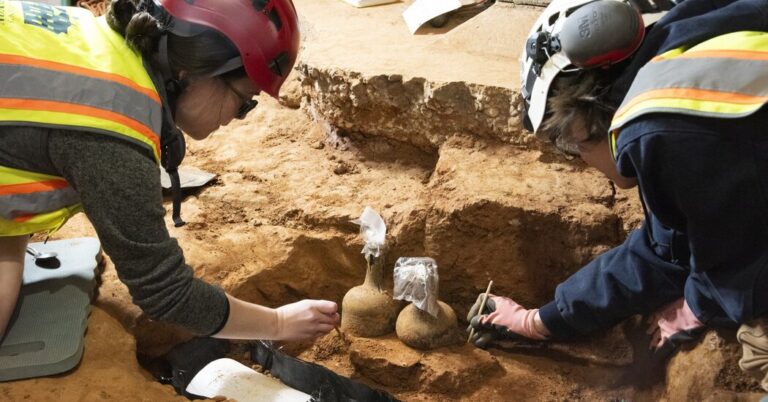The basement of Mount Vernon contained a relic from the final decades of colonial America: a vertical glass jar with the lid containing some sort of liquid. The contents revealed that the jar was intact, unlike the shattered pieces commonly found on the estate.
Working carefully under bright lights beneath George Washington’s Virginia mansion last fall, archaeologists uncovered the first of 35 glass jars in a basement storage pit. Most were intact and contained perfectly preserved fruit, including cherries and berries. Experts say the jars likely offer a link to the slaves who worked there.
“This was a pretty big deal for us,” said Mount Vernon’s lead archaeologist Jason Borrows. “It’s pretty unusual to find a whole jar, but even rarer to find one with its contents still in it.”
Dr Boros said archaeologists began excavating the basement last year as part of a $40 million redevelopment project to preserve the property.
After archaeologists unearthed the first bottle, they placed a bucket over it to protect it, Dr. Borrows said. It wasn’t until March that archaeologists focused their attention on the bottle again, and soon found a second bottle.
According to Dr. Borrows, two of the jars contained whole cherries, as well as cherry parts, pits and stems. As more caches were discovered, the number of jars increased, bringing the total to 35 glass jars, 29 of which contained whole, preserved cherries. Some of the jars had a faint cherry scent; others had a nondescript fruity scent, possibly gooseberry or currant.
“One of the amazing things is that the scent is still there,” he said.
Dr. Borrows said the cherries and berries likely ended up on the Washingtons’ table, but they could have been eaten directly from the jar (archaeologists didn’t taste the centuries-old fruit, he said).
The researchers removed the bottle’s contents and refrigerated it until they could perform scientific analysis. The bottle, which Dr. Borrows said is handcrafted and likely European, is currently drying in an on-site archaeology lab and will be sent offsite for preservation, Mount Vernon said in a news release.
Mount Vernon is working with the Agricultural Research Service, part of the U.S. Department of Agriculture, to process the contents, and experts are examining the seeds to determine whether any are viable.
The discovery may shed more light on the network of slaves who ran the plantations.
Washington inherited Mount Vernon in 1761. Hundreds of men, women, and children belonging to him and his wife, Martha Washington, lived there as slaves for many years.
Dr Borrows said initial findings showed the cherries had been neatly cut with scissors, protecting the cherries and allowing the trees to continue producing, and that the cherries were very clean, suggesting sophisticated techniques were used to pick, pack and store them.
The storage pit was probably used between the 1750s and 1770s, when a brick floor was laid during an expansion of the house. At the time, a slave woman named Dole, who was brought to Mount Vernon by Martha Washington in 1759, was the family’s main cook, Dr. Borrows said. According to letters from Mrs. Washington to her niece in the late 1790s, it’s likely that Dole prepared the bottles herself or had another slave prepare them, Dr. Borrows said.
“From tree to plate, enslaved people did everything at Mount Vernon,” Dr. Borrows said.
Dennis Pogue, an associate research professor at the University of Maryland who served as Mount Vernon’s vice president for conservation, said the discovery sheds light on the daily activities of a household that historians knew about but had not been documented. It also raises questions about Dole and why the jar was left behind.
“The big question is how much we can understand that from our standpoint,” he said.
Cheney McKnight, owner of “Not Your Momma’s History” and a historian and interpreter who has portrayed slave and free cooks in popular videos, said the bottles are a lasting reminder of enslaved people’s endless daily labor and their ingenuity.
“I hope it shows the lives of the people who made it possible for our nation’s first president to actually go out and be president, General George Washington,” McKnight said.

